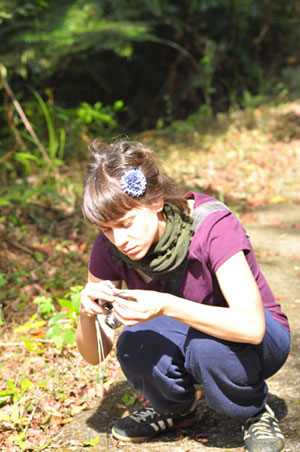We have moved to a new server!
Since March 2014, this website has been moved to this new server: http://web.ntnu.edu.tw/~treehopper/. This page will not be updated anymore. Please update your browser’s bookmark or the web links.
Member list
Current members
- Jo-Fan Wang
- 1. The Territorial Behavior of Euphaea formosa (Odonata). 2. Tempo and Mode of Pronotal Evolution in Membracis Treehoppers.
- Hung-Nien Chen
- 1. The effect of typhoon on survivalship of Matrona cyanoptera. 2. Modes of phenotypic variation in Euphaea amphicyana.
- Lan-Wai Yeh
- Ecology and evolution of Taiwanese Carabus ground beetles.
- Yun-Chieh Cheng
- What do damselfly larvae eat? DNA barcode analyses of larval diet in Matrona cyanoptera and Euphaea formosa.
- Chung-Hsin Huang
- Flucuating Asymmetry and Developmental Asymmetry of Cyclommatus mniszechi.
- Hui-Yun Tseng
- 1. Biological function of coloration in Pachyrrhynchus tobafolius. 2. Phylogeny and color evolution of Pachyrrhynchus weevils. 3. Population genetics of Pachyrrhynchus weevils on Lanyu and Green Island.
- I-Ting Hsiao
- Variation of genitalia in Euphaea amphicyana.
- Yen-Ting Chen
- The effect of forest management of Mt. Da-Shiue on the morphological variation of a ground beetle, Carabus (Apotomopterus) masuzoi.
- Jyun-Huei Huang
- The fighting behavior of a stag beetle, Rhaetulus crenatus.
- Shi-Ting Wu
- Membracis Phyllotropis.
- Chiao-Wei Lin
- The fighting behavior of a stag beetle, Rhaetulus crenatus.
- Yong-Chao Su
- Behavioral ecology, sociobiology, population genetics, and molecular phylogenetics.
Past members
- Wei-Liang Xiao
- Variation of wing veins in Euphaea amphicyana.
- Li-Wen Weng
- Why do firefly larvae emit light?
- Yat-Hung Lee
- Speciation of Euphaea damselflies.
- Che-Yu Kuan
- Variation of mandibles in stag beetles.
- Chu-Yen Cheng
- Phylogeography of a Philippine's treehopper, Leptocentrus reponens.
- Ming-Yu Chen
- Phylogeography and population history of the treehoppers, Centrochares horifficus from the Philippines Archipelago.
- Shao-Chang Huang
- Visual Communication of Matrona cyanoptera
- Jen-Pan Huang
- Population Genetics and Phylogeographic Analyses of Formosan Damselfly, Euphaea Formosa (Insecta: Odonata: Euphaeidae) from Taiwan
- Wei-Yun Chen
- Molecular and Phylogenetic Characterization of Endosymbiotic Bacteria of the Froghopper, Okiscarta uchidae (Insecta: Hemiptera: Cercopidae)
Visiting scholars and students
- Vanitha Williams
- Predatory potential of waterbug, Diplonychus rusticus and dragonfly, Diplacodes trivialis on mosquito larvae.
- Marina Vilenica
- Klaas-Douwe 'KD' B. Dijkstra
- History, diversity and identification of dragonflies and damselflies (Odonata).
- Erin McCullough
- " Diversification of weapon form: aerodynamic costs of beetle horns.
- Ashley E. King
- Intrasexual combat and intersexual antagonistic co-evolution in horned beetles.
Marina Vilenica

Title
Visting student, 2010, Faculty of teacher education, Trg matice hrvatske 12, Petrinja, Croatia
Species: Dragonfly

Project
Dragonfly composition (Insecta, Odonata) in wetland area of Turopolje region, Croatia
Abstrct
E-mail:idioglossia33@yahoo.com
Wetland habitats are the most threatened ecosystems due to water-drainage, excessive exploitation and pollution, which is why they are increasingly disappearing all around Europe. To maintain the high species richness, it is essential to maintain a variety of biotopes. Therefore, wetland area of Turopolje is an important habitat for biodiversity conservation in Croatia. In biodiversity conservation dragonflies serve as umbrella species representing specific biotic wetland assemblages. They are used as bio-indicators for freshwater ecosystems’ quality due to their sensitivity and complex food web. Literature data of the dragonfly findings on Croatian territory are relatively poorly represented. Also, dragonfly fauna in Turopolje area is very poorly researched. The primary objectives of this research were to determine dragonfly fauna and their distribution in Turopolje region. The survey was conducted from August 2007 until May 2009 at 9 localities. All investigated localities differ in their vegetation structure and amount of present water. Vegetation alliance for each locality was determined at a sight. For estimation of dragonfly composition per locality, Shannon-Weaver and Simpson index of diversity were used. 22 species with 307 specimens of dragonflies were determined, most of them belonging to the Libellulidae family. Only 1 species was recorded for families Lestide, Platycnemididae and Corduliidae. Species Calopteryx splendens (Harris, 1782), Coenagrion puella (Linnaeus, 1758) and Ischnura elegans (Vander Linden, 1820) were the most abundant species. On the other hand, species Pyrrhosoma nymphula (Sulzer, 1776), Lestes barbarus (Fabricius, 1798), Brachytron pratense (Müller, 1764), Epitheca bimaculata (Charpentier, 1825), Gomphus vulgatissimus (Linnaeus, 1758), Orthetrum cancellatum (Linnaeus, 1758) and Orthetrum coerulescens (Fabricius, 1798) were recorded only for 1 locality. Also, endangered and protected species Erythromma najas (Hansemann, 1823), Lestes barbarus (Zygoptera), Aeshna isoceles (Müller, 1767), Epitheca bimaculata and Otrhetrum coerulescens (Anisoptera) were recorded. Shannon-Weaver and Simpson index of diversity showed that vegetation structure is one of the main factors that affect the composition of the dragonfly communities. Future investigations should include the entire Turopolje region as well as dragonfly larvae and sheds sampling.

Marina in LianHwaTz Research Station.